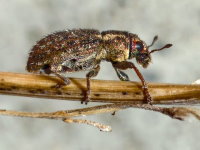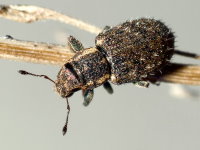Phylum Arthropoda (Arthropods) ➔ Subphylum Hexapoda (Hexapods) ➔ Class Insecta (Insects) ➔ Order Coleoptera (Beetles) ➔ Family Curculionidae (Weevils)
Sitona hispidulus (Fabricius, 1776)
Borstiger Blattrandrüssler Clover Weevil
Synonyms and other combinations:
Curculio geoffroaei Gmelin, 1790 | Curculio griseus Goeze, 1777 | Curculio hispidulus Fabricius, 1777 | Curculio modestus Geoffroy, 1785 | Sitona foedus Gyllenhal, 1834 |
Further vernacular names:
Clover Root CurculioClassification:
Sitona hispidulus belongs to the subfamily Entiminae, tribe Sitonini.Distribution:
Europe, Asia, adventive in North America.Habitat:
Fields, pastures, meadows, wasteland, roadsides, also at higher altitudes - in places where clover grows.Description:
Length 3.5 - 4.5 mm; upper side with scales and hairs; elytra broader than the pronotum, with long projecting bristles, brown spotted; scutellum with scales directed to the rear; pronotum widely coarsely punctured, with paler, narrower middle and wider lateral stripes; forehead flat, with eyelashes; eyes very weakly arched; femora not toothed; claws not intergrown at base.Biology:
The Clover Weevil Sitona hispidulus is a common and widespread species that lives on plants of the pea family (Fabaceae). The weevils prefer wild growing and cultivated Trifolium- and Medicago species.From mid-summer onwards, the adults of the new generation appear. They feed on foliage leaving distictive notches on leaf margins of the host plants. About 6 to 8 weeks after hatching, the females begin to lay their eggs. The eggs are laid in late autumn and the following spring. The imagines and the eggs laid in autumn overwinter. The larvae hatch from April and feed on the roots of their host plants until they pupate. The pupal stage lasts 3 - 4 weeks.
Sitona hispidulus forms one generation per year. The adult beetles are long-lived. Their lifespan is about 1 year.
Natural enemies:
Entomophagous nematodes: Steinernema feltiae, Steinernema bibionis and Heterorhabditis bacteriophora - Nematodes parasitize larvae, pupae and adult beetles.Microctonus aethiopoides (Hymenoptera: Braconidae) - This species parasitizes adult weevils. It lays an egg into the abdomen of the beetle. After hatching the Microctonus aethiopoides larva feeds and develops inside the beetle.
Anaphes diana (Hymenoptera: Chalcidoidea: Mymaridae) - The fairy wasp Anaphes diana is an egg parasitoid of Sitona species.
References, further reading, links:
- Yunakov N. (2017). 3i Curculio: 3i taxonomic databases, Curculionidae, subfamily Entiminae (version Jan 2017). In: Species 2000 & ITIS Catalogue of Life, 2017 Annual Checklist (Roskov Y., Abucay L., Orrell T., Nicolson D., Bailly N., Kirk P.M., Bourgoin T., DeWalt R.E., Decock W., De Wever A., Nieukerken E. van, Zarucchi J., Penev L., eds.). Digital resource at www.catalogueoflife.org/annual-checklist/2017. Species 2000: Naturalis, Leiden, the Netherlands. ISSN 2405-884X.
- Arved Lompe: Die Käfer Europas - Ein Bestimmungswerk im Internet
- Kaitlin Rim, Steven J Price, Erik J Wenninger, Rachael Long, Ricardo A Ramirez: Biology and Management of Clover Root Curculio (Coleoptera: Curculionidae), Journal of Integrated Pest Management, Volume 10, Issue 1, 2019, 23, https://doi.org/10.1093/jipm/pmz020
- Anoplus plantaris
- Anthonomus phyllocola
- Archarius crux
- Archarius sp.
- Barypeithes sp.
- Bradybatus kellneri
- Charagmus gressorius
- Coelositona cambricus
- Coniocleonus excoriatus
- Curculio betulae
- Curculio venosus
- Cyphocleonus dealbatus
- Dryocoetes sp.
- Ellescus scanicus
- Gymnetron sp.
- Hypera sp.
- Larinus sturnus
- Larinus turbinatus
- Liophloeus tessulatus
- Lixus sp.
- Magdalis sp.
- Miarus sp.
- Notaris scirpi
- Orchestes hortorum
- Phyllobius glaucus
- Polydrusus tereticollis
- Rhinoncus pericarpius
- Simo sp.
- Sitona humeralis
- Tachyerges stigma
- Tapeinotus sellatus
- Sphenophorus piceus
- Acorn Weevil
- Alder Flea Weevil
- Ash Weevil
- Cabbage Stem Weevil
- Chestnut Weevil
- Clay-coloured Weevil
- Clover Leaf Weevil
- Clover Root Weevil
- Clover Weevil
- Common Leaf Weevil
- Eight-toothed Spruce Bark Beetle
- European Hardwood Ambrosia Beetle
- Green Immigrant Leaf Weevil
- Green Leaf Weevil
- Green Nettle Weevil
- Ground Weevil
- Hairy Spider Weevil
- Iris Weevil
- Nettle Leaf Weevil
- Nut Leaf Weevil
- Pine Weevil
- Scaly Strawberry Weevil
- Scarce Aspen Catkin Weevil
- Silver-green Leaf Weevil
- Small Nettle Weevil
- Strawberry Blossom Weevil
- Strawberry Root Weevil



